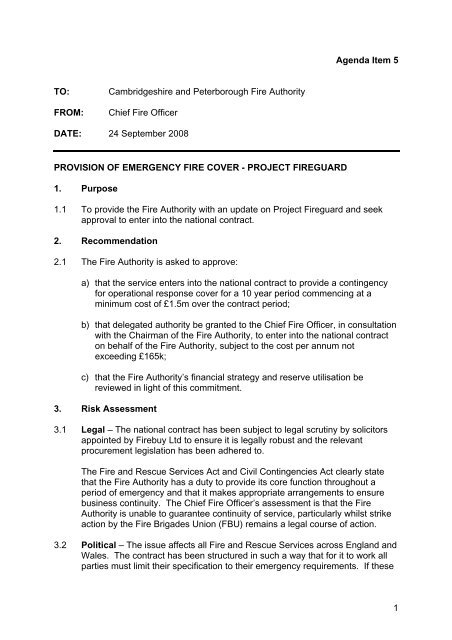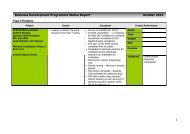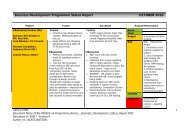Contact: David Howells Director of Corporate Services Tel: 023 ...
Contact: David Howells Director of Corporate Services Tel: 023 ...
Contact: David Howells Director of Corporate Services Tel: 023 ...
Create successful ePaper yourself
Turn your PDF publications into a flip-book with our unique Google optimized e-Paper software.
‘1.17 The Civil Contingencies Act 2004 lays down duties for specified“Category 1 responders”, including the Fire and Rescue Authorities, to assess,plan and advise in relation to emergencies. For a Fire and Rescue Authority,an emergency includes a period <strong>of</strong> industrial action’.‘1.18 Government has worked actively with the Local Government Associationand with The Chief Fire Officers Association to support self sufficiency inemergency cover across the country. It is the responsibility <strong>of</strong> the individualFire and Rescue Authorities to keep under review the levels <strong>of</strong> emergencycover that they deem to be appropriateEach Fire and Rescue Authority must:-Have in place a plan to provide such levels <strong>of</strong> emergency cover as it regardsas appropriate during any period <strong>of</strong> emergency, liaising as necessary withother relevant organisation, but without reliance upon support form the ArmedForces;’4.4 In 2006 and following the guidance contained within the FRS NationalFramework (2006-2008), a number <strong>of</strong> seminars and meetings were held toraise the awareness <strong>of</strong> the Government’s expectations that the Armed Forceswould no longer be able to support deployments within the UK in the event <strong>of</strong>industrial action. FRSs were asked to consider how they could become more‘self sufficient’ and how they could provide a robust and suitable ‘safety net’ toensure they could meet their statutory duties. Some FRSs believed thatresources could be found within their existing pool <strong>of</strong> employees and haveused resilience contracts to attempt to ‘guarantee’ cover in the event <strong>of</strong> afuture dispute. Others were not so confident that such a guarantee could begiven and as a result the Project Fireguard was set up in early 2007 to look atwhether the market was capable <strong>of</strong> providing a suitable and affordable solutionthat could discharge an FRA’s statutory obligations in the event <strong>of</strong> an industrialdispute or other large scale emergency event having a similar effect on theavailability <strong>of</strong> FRS operational staff.5. Project Fireguard5.1 Project Fireguard has now brought together 33 Fire and Rescue <strong>Services</strong> inEngland and Wales in a procurement managed on behalf <strong>of</strong> CFOA by FirebuyLtd. This procurement is being conducted as a competitive dialogue under thePublic Contracts Regulations 2006.5.2 A CFOA Project Board has been established chaired by the Chief Fire Officer<strong>of</strong> the Greater Manchester FRS and comprising a representative from each <strong>of</strong>the participating CFOA regions. In addition each participating FRS hasappointed a Liaison Officer who is responsible for day to day participation inthe project and in particular for managing the information flow between theproject and the individual FRS and for ensuring that actions necessary tosupport the project and its objectives within each individual FRS are taken. Inaddition, throughout the project, advice has been sought from external legaland commercial advisers.3
5.3 It is acknowledged that to provide a full replacement wholetime fire servicewould not be feasible both physically and financially. Therefore each FRS wasasked to realistically estimate what their minimum requirement would be toprovide cover in such circumstances.5.4 A national Project team was established in late 2006 by CFOA. The project,known as ‘Fireguard’, has a full time team dedicated to it. They are based atthe London Fire Brigade Headquarters.5.5 FRSs across England and Wales were invited to be part <strong>of</strong> the initial dialogueand consultation process to help find a viable solution. Liaison Officers fromeach service were appointed to provide information, feedback and report onthe progress. Cambridgeshire Fire and Rescue Service (CFRS) are one <strong>of</strong> the34 FRSs who took part in this process.5.6 CFRS minimum requirement has been included within the initial specification.This is four emergency fire crews covering wholetime appliance locations atCambridge, Huntingdon, Peterborough and Wisbech.5.7 The Project Fireguard team have followed a structured project managementpath and put together the project plan, milestones, initial & final specifications,expressions <strong>of</strong> interest and invitations to tender including a European JournalNotice (OJEU) ensuring all legal and financial aspects have been addressed.5.8 The procurement element <strong>of</strong> the project was undertaken by Firebuy Ltd, thenational procurement consortium <strong>of</strong> the FRS.5.9 Three companies were short-listed as having the potential to supply theservice. A robust evaluation process, involving a variety <strong>of</strong> Fire Servicepr<strong>of</strong>essionals, selected a ‘preferred bidder’. Group 4 Security <strong>Services</strong> UKwas selected, providing the evaluation team with the confidence that theycould provide the service as specified.6. The Solution6.1 The Group 4 Security <strong>Services</strong> UK solution will provide:• 1360 retained staff who will be Group 4 employees (they will not employexisting FRS staff);• 54 or more crews ready for national deployment on a 3 watch system;• deployment for national events in 14 days notice (subject to a 12 monthinitial lead time whilst the contract is established);• availability <strong>of</strong> 25% <strong>of</strong> their staff within 24 hours;• crews to work on CFRS wholetime stations, drive and ride on CFRS fireappliances;• one crew during a nationwide event; CFRS would draw 20% (one crew) <strong>of</strong>specified request, this is discussed further below. However, the contractwill be sufficient to cover local and regional delivery or the demand fromone large Metropolitan area;4
• an ability to call <strong>of</strong>f additional resources from the contract. If a local orsingle region requires to ‘call <strong>of</strong>f’ the service, CFRS would be guaranteed 4crews (as per the specification) but it would be possible to take as manycrews as required if it were for less than 12 hours;• up to 81 crews for a period <strong>of</strong> up to 4 days;• deployable resources in 14 weeks after letting <strong>of</strong> contract due to the use <strong>of</strong>existing Group 4 firefighting staff;• staff trained by the Fire Service College and a training regime to ensureongoing competence in role;• existing Group 4 mobilisation and supervision <strong>of</strong> staff on a three watchsystem;• regional operations managers to build understanding and partnership withparticipating FRSs;• full back <strong>of</strong>fice support for Group 4 staff;6.2 The capacity to cover a national event and the provision <strong>of</strong> only one wholetimeappliance within CFRS, needs to be viewed within the correct context. Shouldpandemic influenza strike nationally then worst case scenarios suggest some40% <strong>of</strong> staff may be unavailable for work. Clearly this would create areduction in service levels but CFRS, through its work with ORH, has detailedknowledge <strong>of</strong> how to position available appliances to best effect. It is onlystrike action by staff that could potentially remove the entire service. Areduction to one wholetime appliance would only occur in the event <strong>of</strong> anational strike. Although strike action remains a legal course <strong>of</strong> action foremployees <strong>of</strong> the fire service, it more likely that industrial action occurringwithin the lifespan <strong>of</strong> the contract will centre on local rather than nationalissues. However, a national strike remains a possibility.7. Other Options7.1 Before considering other options it is necessary to examine the context inwhich the Service operates. Although the project team correctly presentsFireguard as a solution for all threats to business continuity, historically onlyindustrial action by FBU members has seriously disrupted delivery <strong>of</strong> service.This may not be the case in the future but it remains, in the opinion <strong>of</strong> theChief Fire Officer, the most likely cause <strong>of</strong> disruption to service whilst itremains a legal course <strong>of</strong> action for FBU members.7.2 Under the Authority’s existing business continuity management arrangementsplans exist to address a number <strong>of</strong> anticipated scenarios, such plans include:• Section 13 and 16 arrangements with surrounding FRA’s• National Mutual Assistance protocols• Recall to Duty7.3 These plans are tested and proven. However they are not sufficiently robust tomeet legislative requirements without assistance from the military.5
7.4 Whilst some authorities have determined that sufficient resilience exists withintheir existing structures, the Chief Fire Officer does not consider the currentposition within Cambridgeshire to be acceptable. The key reasons for this areoutlined below.7.5 The experience <strong>of</strong> previous strike action within CFRS suggests that currentFBU membership amongst station based staff (81%) is sufficient to remove allwhole time appliances from service. Equally the number <strong>of</strong> flexible duty<strong>of</strong>ficers who are members <strong>of</strong> the FBU (84%) precludes any realistic possibility<strong>of</strong> robustly and safely crewing appliances over a sustained period <strong>of</strong> actionusing <strong>of</strong>ficers only.7.6 Use <strong>of</strong> the retained staff is an option but it must be borne in mind that they toocould be affected by a pandemic, terrorist attack or industrial action. There isalso a question as to whether retained firefighters would be prepared to crosspicket lines. The outcome <strong>of</strong> the ongoing employment tribunal case withregard to retained firefighters and their status as part time employees mayreduce the effective resilience <strong>of</strong> the retained service in the longer term.Currently 33% <strong>of</strong> retained firefighters are members <strong>of</strong> the FBU, and there issignificant potential that more ‘part time’ firefighters may wish to berepresented by the FBU and not the Retained Firefighters Union. Experience<strong>of</strong> past disputes suggests that retained firefighters working through periods <strong>of</strong>industrial action limit their activities to incidents within the station ‘ground’ andaffecting the local community.7.7 The Peterborough Volunteer Fire Brigade (PVFB) has in the past remainedactive during periods <strong>of</strong> industrial action. However, as a volunteerorganisation they are unable to provide the necessary levels <strong>of</strong> availability andresilience to discharge the duties placed upon the Authority. The PVFB couldpotentially provide additional support and local expertise to Fireguard crewswithin the city.7.8 The key areas <strong>of</strong> risk within Cambridgeshire are Peterborough, Cambridge,Huntingdon and Wisbech. Geographically they are some distance apart andthus moving fire cover from one location to another has the effect <strong>of</strong> denudingfire cover. This is significantly different from, for example, a metropolitanauthority where the close proximity <strong>of</strong> stations reduces the impact. Similarly,placing an available appliance between two centres <strong>of</strong> risk can have the affect<strong>of</strong> rendering fire cover in both locations ineffective.8. Level <strong>of</strong> Cover Provided By Fireguard8.1 Members will be aware that the Authority has invested in its EmergencyResponse Model over several years and as a result we are able to determinethe level <strong>of</strong> cover that would be delivered by Fireguard with a high degree <strong>of</strong>confidence.8.2 Clearly one <strong>of</strong> the major factors affecting fire cover is the availability <strong>of</strong> theretained duty system (RDS) and it is not possible to accurately determine whatthat would be in any given set <strong>of</strong> circumstances. However the table below6
details the level <strong>of</strong> cover provided by Fireguard in the event <strong>of</strong> 0%, 50% and100% <strong>of</strong> the retained being available alongside four Fireguard appliances.8.3 At 0% retained availability the model becomes statistically unreliable so resultshave not been included. What is clear is that Fireguard <strong>of</strong>fers an effectiveshort term solution if combined with 50%-100% retained availability.8.4 Disposition <strong>of</strong> appliances also changes with retained availability and thepreferred sites for Fireguard crews are detailed below.8.5 In the event <strong>of</strong> a national strike and only one Fireguard appliance being madeavailable the Service would use its Emergency Response Model to determinethe best location for its available assets.9. Project Costs9.1 The initial cost <strong>of</strong> establishing the contract will be £10 million nationally, withCFRS having to contribute £151,610 towards the total amount. This can bepaid in a lump sum or spread over the life <strong>of</strong> the contract at £19,890 perannum.9.2 Subsequently, annual premiums will be £142k per annum, with the exception<strong>of</strong> Year 1, where it will be £79,860. The on-going contract costs equate to anadditional 1% on a Band D Council Tax bill per annum.9.3 The contract will act as an insurance policy and if we call it <strong>of</strong>f, additional costswill be incurred. For example, if CFRS requested 4 crews for 24 hours, anadditional fee <strong>of</strong> £20k would be payable. If crews were called to cover forindustrial action, then savings would <strong>of</strong>fset the additional fee, throughreclaimed salaries.7
9.4 The project pricing model only holds together if all participating FRSs remaincommitted to it. If the numbers reduce significantly, the contract pricing modelwill potentially become unaffordable.10. Conclusion and Way Forward10.1 Members are requested to consider Project Fireguard and its associated costsas it relates to Cambridgeshire Fire and Rescue Service and to decidewhether to enter into contractual arrangements.10.2 The deadline for FRAs to commit in principle is required by 21 October 2008.10.3 The contract will be awarded from 3 November 2008.BIBLIOGRAPHYSource Documents Location <strong>Contact</strong> OfficerFire and Rescue <strong>Services</strong>Act 2004Civil Contingencies Act2004Fireguard ProjectManagement andSpecificationDocumentationHinchingbrooke CottageBrampton RoadHuntingdonHinchingbrooke CottageBrampton RoadHuntingdonHinchingbrooke CottageBrampton RoadHuntingdonMatthew Warren01480 444619matthew.warren@cambsfire.gov.ukMatthew Warren01480 444619matthew.warren@cambsfire.gov.ukDave Robertson01480 444557dave.robertson@cambsfire.gov.uk8





